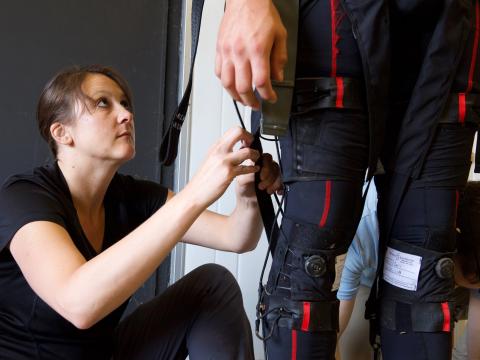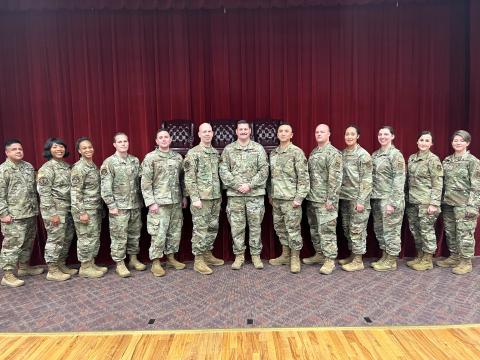Ground Forces Uplink To Orbital Sensors
Portable system is first step to future battlefield awareness tool.
A series of mobile groundstations soon will provide commanders with real-time detection and trajectory information about enemy theater and strategic missiles. Developed to operate with a new constellation of advanced early warning satellites, the air-transportable facilities will enhance the survivability of U.S. expeditionary forces.
Since the dawn of the Cold War, ground- and, later, space-based systems have been in place to warn of an imminent enemy attack. In the early 1990s, with the demise of the Soviet Union and the rise of regional conflicts, a different type of threat emerged in the form of theater ballistic missiles. Iraqi scud missile attacks on coalition forces during the Gulf War highlighted the need for mobile facilities that could provide regional headquarters with accurate missile warning data.
The multimission mobile processor (M3P), a transportable groundstation, is designed to meet the early warning, command and control and battlefield awareness needs of future expeditionary forces. It would replace the current mobile groundstation—the U.S. Army and U.S. Navy joint tactical groundstation (JTAGS). This change in terrestrial facilities also reflects a similar shift occurring in orbit.
JTAGSs receive their data from the Defense Support Program (DSP), a constellation of early warning satellites first launched in the 1970s. Originally designed to provide early warning about strategic missile attacks during the Cold War, the DSP has been modified to provide regional and theaterwide detection and tracking. According to Dr. Daryoush Tehranchi, executive manager for defense advanced programs at Silicon Graphics Incorporated (SGI) Federal, Denver, Colorado, JTAGS was developed in 1991 to provide commanders with a battlefield DSP capability by directly processing data from satellites. The groundstations were used in the Gulf War to alert coalition generals about Iraqi scud missile launches and to provide trajectory information to vector in Patriot missile interceptors, he says.
However, despite upgrades, the DSP represents 30-year-old technology. Its replacement is the space based infrared system (SBIRS), which will consist of two satellite constellations and a number of fixed and mobile groundstations. Like the DSP, SBIRS will provide early warning and tracking data of enemy strategic and theater ballistic missiles. According to U.S. Air Force officials, the system will be more capable than the DSP in furnishing theater commanders with accurate launch warnings and calculated impact areas.
Scheduled for launch in 2004, the first SBIRS constellation will consist of six spacecraft: four located in geostationary orbit and two in highly elliptical orbits. After 2004, a second constellation of 20 or more satellites will be launched into low-earth orbits.
The Air Force views SBIRS as an evolutionary rather than a revolutionary idea, Col. Michael W. Booen, USAF, SBIRS assistant program director, Air Force Materiel Command, Los Angeles Air Force Base, California, explains. There will be a period of overlap as the first SBIRS satellites are launched and the last DSP spacecraft are placed in orbit—the final DSP satellite will be orbited in 2003. He notes this approach will be taken with both systems’ groundstations. The M3Ps will initially work with the DSP constellation, but will be upgraded to operate with SBIRS when it enters service.
The M3P will replace JTAGS and Air Force mobile stations for peacetime and wartime operations, Lt. Col. Craig Bergquist, USA, deputy M3P program manager, Joint Tactical Groundstation Project Office, Huntsville, Alabama, says. Nine stations will be built: five for the Army and four for the Air Force, with both services sharing technology and development costs. Army M3Ps will be used in theater-oriented conflicts, while the Air Force stations will serve in a strategic role. Col. Bergquist notes that crews for the mobile facilities will be pulled from Air Force and Army personnel borrowed from Patriot missile units. The Army crews will be trained to understand theater operations while Air Force personnel will study missile warning techniques and their strategic consequences.
This training distinction is important because a certain level of false alarms can be tolerated in theater operations; however, there is no room for mistakes in strategic situations, Col. Booen explains. He notes that the new system will be more capable than the DSP because it will provide better operational parameters in areas such as cuing air defense weapons, launch point search, attack operations and passive defense. These capabilities were not as developed during the Gulf War, the colonel explains. In that conflict, F-15 pilots hunting Iraqi mobile scud launchers could not receive timely information about launcher locations before the equipment was moved and hidden. SBIRS will allow future pilots to obtain accurate launch point estimates to kill mobile launch facilities before they can relocate, he says.
Col. Booen maintains that passive defense is another area where SBIRS and the M3P system will be valuable. During the Gulf War, DSP satellites could predict only a very broad impact footprint for incoming missiles. Entire target countries and operational regions were disrupted during attacks because of the limited amount of data about missile impact points. The colonel claims SBIRS will be precise enough to tell commanders which side of a specific base an incoming weapon will hit. This capability will allow units in a target area to take defensive measures without slowing down operations across the entire theater, he says.
The M3P will be housed in a 42-foot container used for the theater high altitude area defense (THAAD) system’s ground-based radar. The station can be transported aboard Air Force C-130, C-17 and C-5 cargo aircraft. Like JTAGS, the facility will have antennas for receiving and broadcasting satellite data. However, M3P facilities will have small radomes housing triband antennas that receive DSP, SBIRS and MILSTAR signals. This is an improvement over the JTAGS antenna, which could only receive DSP transmissions, Col. Bergquist explains.
Silicon Graphics servers and workstations will provide the processing and imagery necessary for groundstations to monitor real-time satellite data. Tehranchi notes that SGI has been involved in the SBIRS program from its launch in 1996 and that the company has supported the DSP program for the past 14 years. He believes that SGI’s new server technology is important to meeting SBIRS mission requirements because the M3Ps have four times the computer capability of the JTAGS units. Without the new equipment, the current technology would not have met the program’s mission goals, he observes.
Each M3P groundstation will have two SGI Origin 3000 servers and three ruggedized SGI Onyx 3000 series visualization systems. The Origin 3000 devices come in modular sections that can be combined to create small to very large systems from a common set of building blocks. These components can be central processing units, router interconnects, base input/output modules, peripheral component interconnect expansion modules, graphics modules, disk storage, or individual power supply units. Both the Origin 3000 and Onyx 3000 run on SGI’s IRIX operating system, which is a UNIX-based 64-bit system designed for high-performance computing, advanced visualization and supercomputing.
Should a major component fail, the modular design allows it to be replaced without shutting the system down. This “hot swapping” technique is extremely important because the M3P will process real-time satellite data. If the computer is down, potentially vital information could be lost. “It’s like changing your alternator while your car is running,” Tehranchi explains. SGI has currently delivered more than 512 Origin 3000 processors to the SBIRS program in 16, 24 and 32 processor machines.
The visualization workstations are driven by Onyx2 and 3000 machines featuring dual- and triple-read/write heads. The Onyx systems provide real-time, high-resolution graphics to the groundstations, allowing operators direct interaction with the mission. Tehranchi claims that SGI is the only vendor providing three-head displays. Usually this type of head arrangement weakens graphics quality through color loss and bit mapping. SGI addresses these problems by providing the same type of throughput to all of the groundstations’ displays, eliminating any effect on graphics quality, he says.
Nearly 130 Onyx2 processors are being used across the SBIRS program for visualization purposes. Because the systems can be seamlessly integrated with customer systems, installation is essentially plug-and-play, Tehranchi explains. This capability is important because legacy SGI systems within the DSP require continued interoperability during the shift to SBIRS. The technology allows users the flexibility to upgrade the system because new components can fit into existing applications, he says.
The Air Force and Army saved money when ruggedizing the SGI equipment for use in the groundstations. While the Onyx stations had to be modified to meet military requirements, the Origin 3000 servers were so robust that they did not have to be modified, Tehranchi explains. The DSP and SBIRS programs have also been the largest purchasers of SGI Onyx system machines, with more than 370 dual- and triple-head workstations sold, he adds.
The M3P stations will enter service in 2003, a year before the first scheduled SBIRS geosynchronous satellite launches, Col. Booen says. The stations will begin working with the DSP system and receive software upgrades once the new constellations are online.



